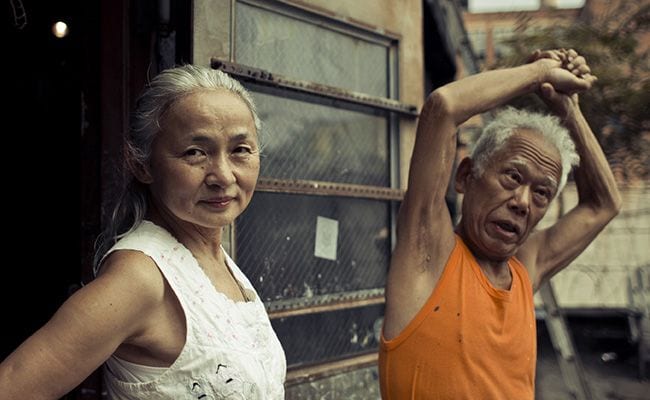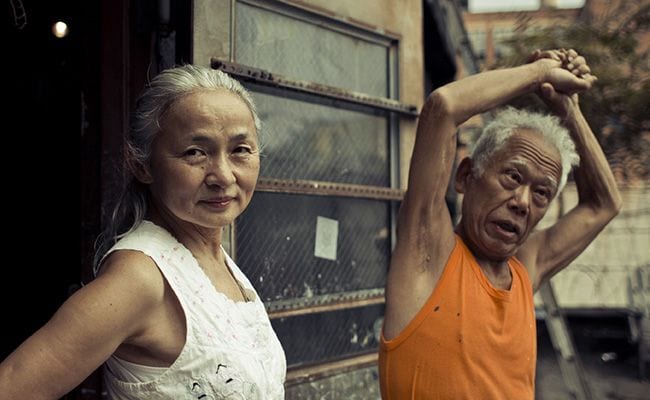
“So isn’t it about time you listened?”
— Noriko, Cutie and the Boxer
“Cutie looked good back when she arrived in New York City.” The pen-and-ink illustration remembering Cutie during the 1960s shows her robust and athletic, her pigtails stuck out as if on wires. In Times Square, buildings warp and stretch into the sky, her eyes wide as she absorbs the new world she’s found. It’s a world shaped by jazz and art, a world vibrating with energy, not wholly knowable. Just so, it’s a world that reflects and helped to shape the woman who arrived and who also remembers arriving, Noriko Shinohara.
Noriko’s experience provides something like a structure for Cutie and the Boxer, a journey of self-invention and discovery, of love and loss. Airing as http://www.pbs.org/pov/cutieandtheboxer/”>part of PBS’ POV series on 18 September, the film details the difficulties of maintaining marriage and creating art, as these efforts overlap and sometimes compete.
That experience also, in its retelling through the simultaneously spare and stout drawings of Cutie (and her aptly named husband Bullie), is aspirational, a means to rethink past and future, to assert identity and hope too. In the film, Cutie is transformed, becoming not only fantastic, but also animated, as the drawings move on screen and soundtrack music helps you to imagine the self Noriko has imagined. That imagining has a context too, indicated by Cutie’s titular partner, who is also Noriko’ husband, Ushio, an artist whose signature work is a series of canvases he’s punched with boxing gloves covered with paint.
These canvases are large and wide, and Ushio is making one as the film opens. It’s his 80th birthday, and Noriko helps him to prepare for his day, as she always does, preparing his breakfast, surprising him with his birthday cakes and a gift (a pair of fuzzy duck slippers), then tying on his gloves so he can go to work and photographing him as he works. At their tiny table in their tiny apartment, they banter, perhaps for the camera. Now that he’s old, he says, “I don’t listen to you.” She comes back, “It has nothing to do with turning 80, you never listened.” And the she adds, “So isn’t it about time you listened?”
It may be about time, but their habits — like their jokes — are familiar. They’re also illustrated in Zachary Heinzerling’s documentary, which looks back and forward, retracing their steps, as young lovers and partners in the city, on to their current routine, Ushio’s painting and sculpting, Noriko’s sketching, their coming together in exchanges that are sometimes combative, sometimes loving, always knowing. What each knows, you come to see, differs, even as they share some 40 years of marriage. “I’m sure you can tell,” Ushio nods at the camera on his wife’s exit from the apartment on yet another errand for him, “Noriko doesn’t really want to help. She’s just an assistant,” he goes on, “An average one has to support the genius, that’s what I think.”
You can also tell, perhaps, that Ushio has a stake in believing what he tells you, or at least in saying that he does. The film goes on to show each partner alone, each given to personal memories or complaints, suggesting both their shared history and their dissimilar views of that history, the rhythms and needs that have divided them and also keep them together. His career keeps Ushio focused: old black and white reports show him collecting cardboard on the street, and Edwin Newman observes that if “the quality, to say the least, is in doubt,” the work — labor and piece — is plainly possessed of a “frenetic energy”; in another shot, he sits with Warhol, “in the limelight of US mass media.”
Such memories-as-TV are rendered here with jazz music and smash cuts, the art and its marketing equally vibrant. At the same time, he frets, the film suggests in home movie bits of his late nights drinking with friends, reframed in Noriko’s drawings as parties and toasts to “Bullie.” She notes as well, over more home movies of their son Alex, that “I did the best I could to raise my child. Because he came from a poor family with an alcoholic parent, he had a strong inferiority complex.” Cutie and the Boxer doesn’t explore this ongoing dynamic, only shows an adult Alex coming to visit, standing at the edges of shots, the family’s interactions minimal on screen, tensions hovering, off.
Repeatedly the film evokes what’s unseen and unspoken, its compositions vivid with color and motion and sometimes stillness too. When Ushio leaves for an afternoon, Noriko is abruptly, gently mobile, the camera following behind her as if trying to keep up. She makes her way to the rooftop of their apartment building, where they keep lounge chairs; looking into the wide sky, she muses, “When Ushio is gone, suddenly the air clears and it gets very quiet.”
As a young wife, she says while you see old home movies and photos, the couple smiling as they create the patterns they now inhabit so fully. “I was just following him.” Now, she keeps her time, she uses it to paint and invent. In her work, Bullie may be menacing but Cutie is awesome, flitting from one edge of the page to another, fast and agile and virtuosic. “Female artists need to be strong to succeed,” she observes, “Cutie is completely my work. She doesn’t want to be put in a mold.”
Here, as the movie considers the relationship between success and inspiration, between costs and confidences, you see Ushio alone, again, swimming, his face underwater as you hear his voiceover; “Art is a demon, a demon that drags along,” he says, “It’s not something you can stop, even if you should. Maybe you go insane, maybe your wife leaves you or your kid runs away. You throw yourself away to be an artist.” And as he emerges, breathes and gulps air, you might think about his boxing, his painting, his working — all activities in process. However Ushio imagines his own tragedy (or success), however he sees Noriko, she sees herself apart, too. And while he ponders his demon, she embraces hers.


![Call for Papers: All Things Reconsidered [MUSIC] May-August 2024](https://www.popmatters.com/wp-content/uploads/2024/04/all-things-reconsidered-call-music-may-2024-720x380.jpg)



